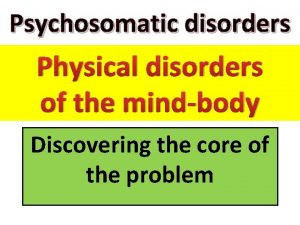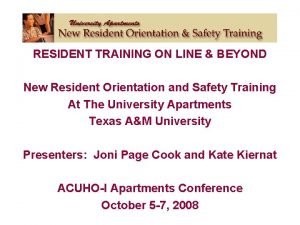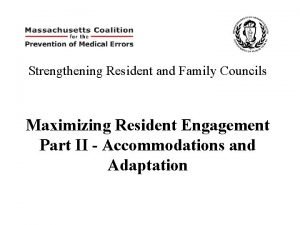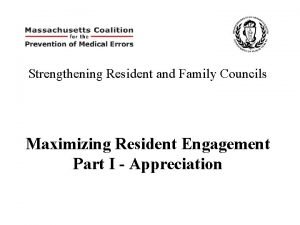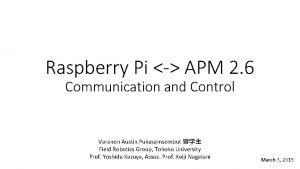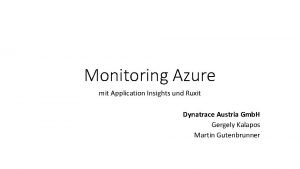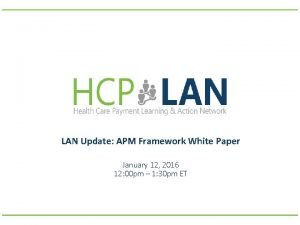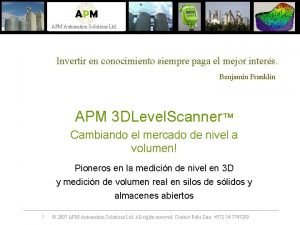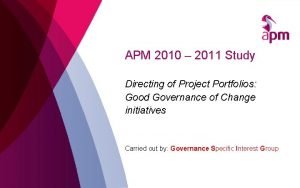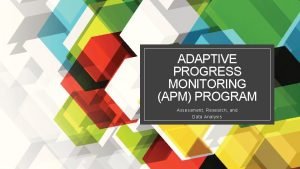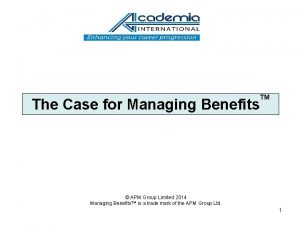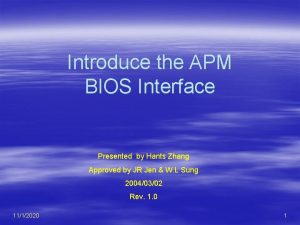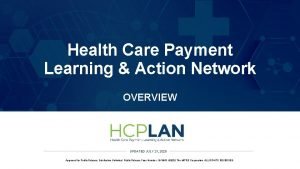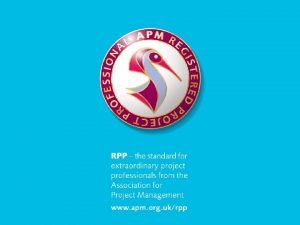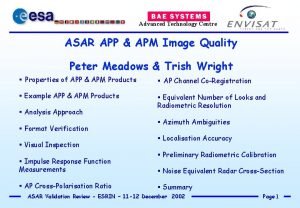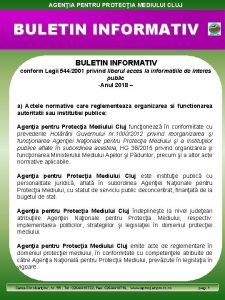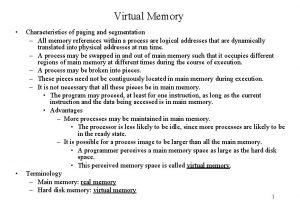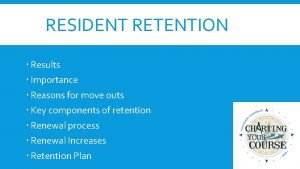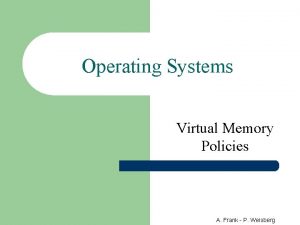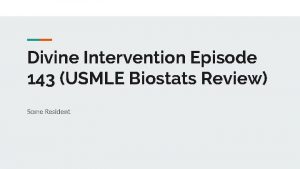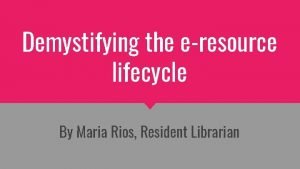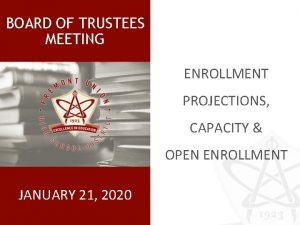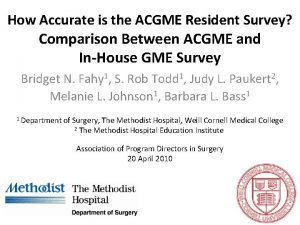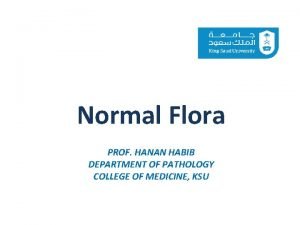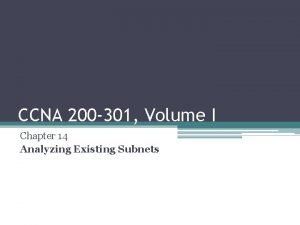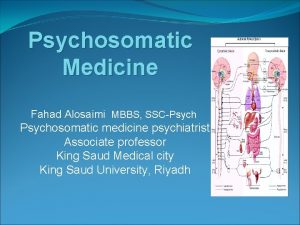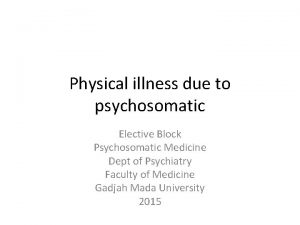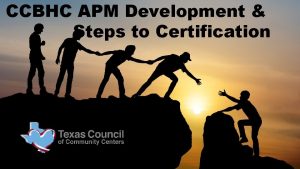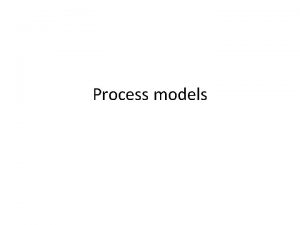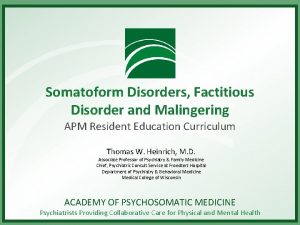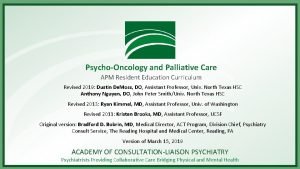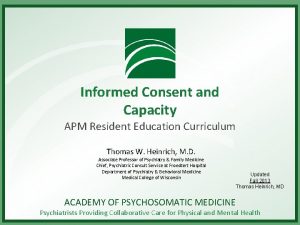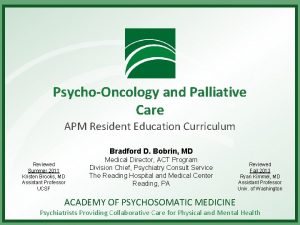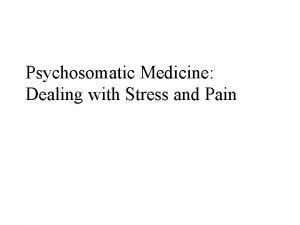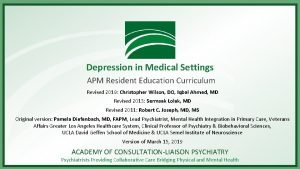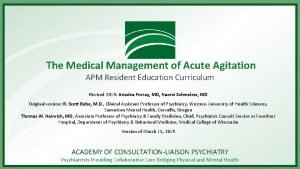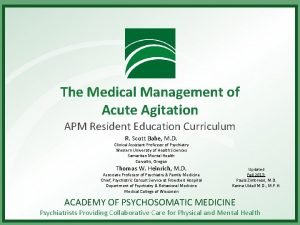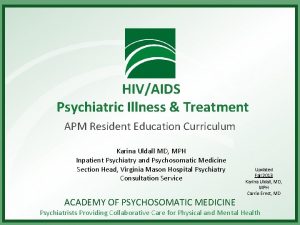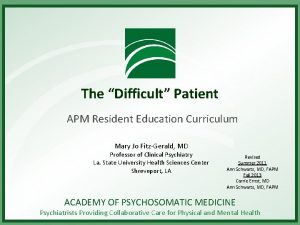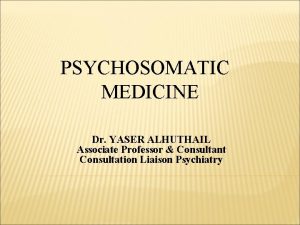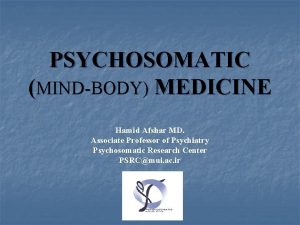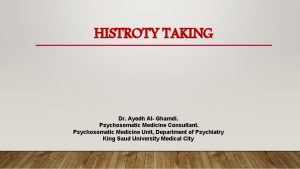Models and Process of Psychosomatic Medicine APM Resident







































- Slides: 39

Models and Process of Psychosomatic Medicine APM Resident Education Curriculum Revised 2017: Jeanne Lackamp, MD Revised 2013: Robert Joseph, MD, MS, R. Brett Lloyd, MD, Ph. D Original version 2011: Robert Joseph, MD, MS Version of March 15, 2019 ACADEMY OF CONSULTATION-LIAISON PSYCHIATRY Psychiatrists Providing Collaborative Care Bridging Physical and Mental Health

Learning Objectives § Describe different models of CL Psychiatry and differentiate from traditional officebased psychiatric care § Identify essential tasks of the CL psychiatrist § List the steps on a psychiatric consultation and the elements of the consult note § Review different methods and structure of integrated mental health care programs Academy of Consultation-Liaison Psychiatry 2

Introduction § “Psychosomatic Medicine” + “Consultation-Liaison Psychiatry” + “Integrated Care” + “Collaborative Care” share core features § Goals? – Assist patients with mental health concerns within a medical context – Make mental health concerns relatable and understandable for medical colleagues – Improve patient lives via collaboration with medical colleagues Academy of Consultation-Liaison Psychiatry 3

Psychosomatic Medicine § Subspecialty at the interface of Medicine and Psychiatry – Clinical service – Research – Training § Consultation Liaison (CL) Psychiatry is the current name of the accredited subspecialty – Feb 2017: American Board of Psychiatry and Neurology petitioned American Board of Medical Specialties (on behalf of Academy of Psychosomatic Medicine) to change the name back to “Consultation-Liaison Psychiatry”- granted – Nov 2017: APM voted to change its name to ACLP Academy of Consultation-Liaison Psychiatry 4

Models of CL Psychiatry § Traditional/Conventional – Hospital- or ambulatory-based – “Consultation upon request” (reactive) – Liaison psychiatry § Mental Health Integration – – – Hospital- or ambulatory-based Case finding/screening Proactive/systemic mental health involvement Population-based programs Disorder-specific programs § Hybrid Models Academy of Consultation-Liaison Psychiatry 5

Traditional Models § “Consultation upon request” – Reactive – Patient- and consultee-specific – Primary responsibility for patient remains with consultee § Liaison psychiatry components – Support § Service, ward, nursing staff § Can be specialty specific (OB, Oncology, Neurology etc. ) – Education § Formal and informal education Academy of Consultation-Liaison Psychiatry 6

Types of Patients § Complex, co-morbid psychiatric and medical conditions § Neurocognitive disorders § Somatic symptom and functional disorders § Psychiatric disorders secondary to medical conditions or treatments Academy of Consultation-Liaison Psychiatry 7

Distinctions from Office-Based Psychiatry § Services are requested by consultee – Rare “self referral” by the patient – Obligations to consultee as well as patient § Patient is often unaware of referral § Participation may be limited – Patient may be ill, uncomfortable, or in pain – Patient motivation is often compromised – Privacy issues abound on inpatient med/surg wards § Visits are not scheduled nor time based Academy of Consultation-Liaison Psychiatry 8

Function of Psychiatric Consultation § Doctor-to-doctor communication designed to address the mental health needs of the patient and improve patient care § The over-riding concern is the patient’s well-being Academy of Consultation-Liaison Psychiatry 9

Essential Tasks § Complete a comprehensive psychiatric assessment and develop a reasonable management plan § Remove impediments to medical care § Bring a fresh perspective to the clinical dilemma § Facilitate a mutual understanding between patient, doctor, and treatment team § Educate the consultee about the emotional and neuropsychological needs of the patient Academy of Consultation-Liaison Psychiatry 10

Steps in the Consultation (1) § Review chart and identify consult question § Discuss case with consultee – To help delineate the manifest question and help identify any latent question(s) – To help consultee reformulate their question, in a manner which addresses underlying issues and allows the consultant to be most helpful – To help consultee with appropriate expectations of the consultant (what can/cannot be gained by consultation) Academy of Consultation-Liaison Psychiatry 11

Steps in the Consultation (2) § Determine urgency – Routine versus urgent versus emergent § Patient interaction – Introduce self and sit down – Share your reason for being there – Address patient’s surprise at the arrival of a psychiatrist (if present) and diffuse tension (as needed) – Attend to any physical discomfort – Perform thorough interview – Answer patient questions as able Academy of Consultation-Liaison Psychiatry 12

Steps in the Consultation (3) § Mental status exam – Includes bedside cognitive testing § Targeted physical exam (if appropriate) § Ancillary history gathering is often appropriate – Family – Additional caregivers – PCP – Pharmacy – Other Academy of Consultation-Liaison Psychiatry 13

Steps in the Consultation (4) § Written note § Verbal communication (feedback) with consultee, regarding your opinion § Follow-up visits as appropriate – Range from none to daily Academy of Consultation-Liaison Psychiatry 14

The Written Note (1) § Formally addressed to the physician requesting the consultation § Designed to be used by other members of the treatment team(s) who are treating the patient § May be read by a variety of hospital personnel – Consider the audience – Consider confidentiality – Consider medico-legal implications Academy of Consultation-Liaison Psychiatry 15

The Written Note (2) § Title – “Psychosomatic Medicine” or “Psychiatry CL Service” § Author(s) – Attending – Resident/fellow – Other § Nature of the note – Initial Consultation Note – Follow-up Consultation Note Academy of Consultation-Liaison Psychiatry 16

The Written Note (3) § Date and Time – Particularly important when dealing with fluctuating mental status § Source(s) – Patient, family, medical record, other § Identifying statement – This lays the groundwork for your formulation and recommendations in a way that helps the readers to understand your note Academy of Consultation-Liaison Psychiatry 17

The Written Note (4) § Reason for consultation – Why did the primary treatment team request a psychiatric evaluation? – There is often a difference between what the primary team requests and what they actually want from the psychiatrist § Manifest request: R/O depression § Latent request: There is nothing actually wrong with this patient. She is manipulative and difficult. Please make her behave! Academy of Consultation-Liaison Psychiatry 18

The Written Note (5) § Identifying statement – Important! – “The patient is a 34 year old male admitted for abdominal pain with a history of multiple medical complaints and pain unresponsive to usual interventions. Psychiatry CL team was asked to evaluate him for possible depression. ” – A reiteration of the manifest question § Reminds us to answer the question § Respectful to consultee Academy of Consultation-Liaison Psychiatry 19

The Written Note (6) § History of present illness (HPI) – Documents the essential positive and negative aspects of the history – Provides a historical framework for understanding the patient § Must include DSM descriptive characteristics and review of systems relevant to patient diagnosis § Consider the following – – – Special events of the patient’s life (e. g. , losses, illnesses) Precipitants of the current psychological and physical difficulties Nature of the patient’s reaction to these precipitants Usual coping mechanisms and ability to implement them Availability of support systems (e. g. , family/friends) Academy of Consultation-Liaison Psychiatry 20

The Written Note (7) § Past Medical/Surgical History – Include menstrual and obstetric as applicable § Past Psychiatric History – Include past diagnoses, treatments, hospitalizations, suicide attempts § Medication – Prior to admission – At time of consultation – Recent changes § Substance Use History – Include history of complicated withdrawal, and MAT details as needed § Family History § Social History – Include upbringing, abuse, legal, military, violence/legal as applicable Academy of Consultation-Liaison Psychiatry 21

The Written Note (8) § Physical Exam (as appropriate) § Mental Status Exam – Is analogous to the physical examination – Reflects one point in time – Addresses the question of the consultation and your formulation within the mental status examination – Provides an opportunity to teach and to demonstrate how diagnoses are made – Helps the clinician gain access to a patient’s mental life § Pertinent laboratory and radiologic findings Academy of Consultation-Liaison Psychiatry 22

The Written Note (9) § Assessment/Impression – Other than recommendations, the most likely part of the consult to be read – Should have the components of a good biopsychosocial formulation, but avoid psychiatric jargon whenever possible § Know your audience and what you want to accomplish § Include stressors and functional status – Differential diagnosis, including personality disorders and medical disorders Academy of Consultation-Liaison Psychiatry 23

The Written Note (10) § Diagnosis – DSM-5 is the primary diagnostic framework – List ICD-9 -CM V codes related to psychosocial and environmental problems – WHODAS may be used to demonstrated disability Academy of Consultation-Liaison Psychiatry 24

WHODAS: World Health Organization Disability Assessment Schedule 2. 0 § Axis V (GAF) was dropped from DSM-5 • Included in Section III of the DSM-5 • Domains include: Communication, getting around, self-care, relationships, household activities, school and work activities, participation in society § 36 -item, self-administered measure used to assess disability in adults (age 18+) § WHODAS is included for further study as an assessment tool for functioning Academy of Consultation-Liaison Psychiatry 25

The Written Note (11) § Plan/Recommendations – Most likely part of the consultation to be read! – Safety elements (e. g. , does patient require 1: 1 observation) – Further work-up suggested (e. g. , labs, EKG, imaging, EEG) – Physician management § Medication – scheduled and PRNs, with specific indications § Behavioral approaches with patient – be clear, avoid jargon – Nursing management (e. g. , restraint initiation/limitations) – Social service needs – Legal issues (e. g. , legal guardian, involuntary transfer status) – Aftercare plans – Consultant follow-up § Inform treatment team of your availability, whether/when you will return, and the purpose of your return Academy of Consultation-Liaison Psychiatry 26

Mental Health Integration (1) § “Psychosomatic Medicine” + “Consultation-Liaison Psychiatry” + “Integrated Care” + “Collaborative Care” share core features § Goals? – Assist patients with mental health concerns within a medical context – Make mental health concerns relatable and understandable for medical colleagues – Improve patient lives via collaboration with medical colleagues Academy of Consultation-Liaison Psychiatry 27

Mental Health Integration (2) § Collaboration within multidisciplinary team framework – Mental Health (MH) + non-Mental Health (non-MH) providers – Psychiatrist, other MDs, Ph. Ds, SW, NPs/PAs, RNs, case managers, support staff § Elements of integration – Mission § Optimal care for mental health/behavioral issues in non-MH setting – Target population § Patients with co-morbid medical and psychiatric problems § Patients with MH problem but no other MH care – Location § Generally involves co-location of MH staff in medical site – Communication § Team meetings, shared medical records, shared treatment plans – Administration § Shared or coordinated efforts between MH and non-MH staff – Fiscal § Integrated budget for MH and medical staff vs. separate Academy of Consultation-Liaison Psychiatry 28

Mental Health Integration (3) § General hospital-based – Tends to be disorder specific § E. g. , delirium, transplant, or substance use disorder teams in the general hospital setting § Ambulatory – Primary care clinics – Medical/Surgical specialty clinics § OB, Oncology, Neurology, Transplant etc. Academy of Consultation-Liaison Psychiatry 29

Mental Health Integration (4) § Rationale – Improved access § Need for improved access to MH services § Patient reluctance to go to MH clinic – Patient-centered care § Prevalence of mental health (MH) issues in medical settings – Improved medical and psychiatric clinical outcomes § Extensive co-morbidity of medical and MH disorders § Bidirectional adverse effect of co-morbid disorders § Associated morbidity and cost of disorders Academy of Consultation-Liaison Psychiatry 30

Mental Health Integration (5) § Method/structure – Reactive programs § Mimic traditional consult services, except perhaps for co-location – Planned programs § Highly structured, oriented toward “Disease Management” § Value added – Delirium prevention programs – Anxiety, depression, bipolar disorder, schizophrenia, and substance use disorder management in primary care – Co-morbid MH and medical disorders § Depression, diabetes, cardiac disorders – Medically Unexplained Physical Symptoms (MUPS) Academy of Consultation-Liaison Psychiatry 31

Mental Health Integration (6) § Planned care framework – Addressing behavioral health disorders in medical clinics – Derivative of chronic disease management programs – Over 70 randomized control trials have established value of collaborative care for patients with mental health issues Academy of Consultation-Liaison Psychiatry 32

Mental Health Integration (7) § Methods – Proactive screening/case identification by designated team members – Patient-centered care § Co-location does not equal collaboration – Population-based care § Create patient registries and tracking methods to monitor progress – Algorithm- or otherwise evidence-based treatments – Measurements § Based on tracking results, changes are made until treatment is effective – Team management and case management – Accountable care § Providers are held accountable (and reimbursed) based on quality of patient care and outcomes, not merely the volume of patients Academy of Consultation-Liaison Psychiatry 33

Mental Health Integration (8) § Psychiatrist role as a collaborative care team member? – Receive referrals and “warm hand-offs” from primary care colleagues – Consult and provide supervision on a scheduled and PRN basis, for an identified caseload of patients followed in the medical clinic – Function as the team expert § Support the team as they engage with the patient § Give mental health input and suggestions for evidence-based care – Function as an educator § Teach medical colleagues clinically-relevant and evidence-based information, with relevance for the patient cohort in question Academy of Consultation-Liaison Psychiatry 34

Conclusions § “Psychosomatic Medicine” + “Consultation-Liaison Psychiatry” + “Integrated Care” + “Collaborative Care” share core features § Goals? – Assist patients with mental health concerns within a medical context – Make mental health concerns relatable and understandable for medical colleagues – Improve patient lives via collaboration with medical colleagues THANK YOU! Academy of Consultation-Liaison Psychiatry 35

REFERENCES § Alexander T, Bloch S. 2002. The written report in consultation-liaison psychiatry: A proposed schema. Australian and New Zealand Journal of Psychiatry 36: 251 -258. § Ash JS, Berg M, Coiera E. 2004. Some unintended consequences of information technology in health care: The nature of patient care information system-related errors. JAMIA 11: 104 -112. § Campbell EM, Sittig DF, Ash JS et al. 2006. Types of unintended consequences related to computerized order entry. JAMIA 13(5): 547 -556. § Garrick TR, & Stotland NL. 1982. How to write a psychiatric consultation. Am J Psychiatry 139(7): 849 -855. § Gilbody S et al. 2006. Collaborative care for depression, accumulative meta-analysis and review of longer-term outcomes. Arch Intern Med 166: 2314 -2321. § Goldman L, Lee T, Rudd R. 1983. Ten commandments for effective consultations. Arch Intern Med 143: 1753 -1755. § Kathol R et al. 2009. Psychiatrists for medically complex patients: Bringing value at the physical health and mental health/substance-use disorder interface. Psychosomatics 50(2): 93 -107. Academy of Consultation-Liaison Psychiatry 36

REFERENCES § Katon W et al. 2010. Collaborative care for patients with depression and chronic illnesses. N Engl J Med 363: 2611 -2620. § Kontos N; Querques J. Psychiatric consultation to medical and surgical patients. 2008. In: Stern TA, Rosenbaum JF, Fava M, et al. eds: Massachusetts General Hospital Comprehensive Clinical Psychiatry. Philadelphia: Mosby. Elsevier. 749 -760. § Meyer F, Joseph RC, Peteet JR. 2009. Models of Care for Co-occurring Mental and Medical Disorders. Harvard Review of Psychiatry 17(6): 353 -60. § Press MJ et al. 2017. Medicare payment for behavioral health integration. N Engl J Med 376(5): 405 -407. § Salerno, SM et al. 2007. Principles of effective consultation: An update for the 21 st-century consultant. Arch Intern Med 167: 271 -275. § Shannon D. 2012. Effective physician-to-physician communication: an essential ingredient for care coordination. Physician Exec 38(1): 16 -21. Academy of Consultation-Liaison Psychiatry 37

REFERENCES § Smith G; Clarke D. 2006. Assessing the Effectiveness of Integrated Interventions: Terminology and Approach. Med Clin N Am 90: 533 -548. § Sola CL, Bostwick JM, Sampson S. 2007. Benefits of an Electronic Consultation-Liaison Note System: Better Notes Faster. Academic Psychiatry 31(1): 61 -63. § Venkat KK. 2015. Short and sweet: Writing better consult notes in the era of the electronic medical record. Cleveland Clinic Journal of Medicine 82(1): 13 -17. § Weiner, JP et al. 2007. e-Iatrogenesis: The Most Critical Unintended Consequence of CPOE and other HIT. JAMIA 14(3): 387 -388. § Williams J et al. 2007. Systematic Review of Multifaceted Interventions to Improve Depression Care. General Hospital Psychiatry 29: 91 -116. Academy of Consultation-Liaison Psychiatry 38

REFERENCES § https: //aims. uw. edu/resource-library § http: //www. practicefusion. com/health-informatics-practical-guide-page-9/ § https: //www. nitrd. gov/pubs/pitac/ § http: //iom. nationalacademies. org/Reports/2003/Key-Capabilities-of-an-Electronic-Health-Record-System. aspx § https: //www. healthit. gov/providers-professionals/benefits-electronic-health-records-ehrs § http: //searchhealthit. techtarget. com/definition/HITECH-Act § https: //www. cms. gov/Regulations-and-Guidance/Legislation/EHRIncentive. Programs/downloads/MU_Stage 1_Req. Overview. pdf § http: //iom. nationalacademies. org/About-IOM. aspx Academy of Consultation-Liaison Psychiatry 39
 Psychosomatic
Psychosomatic What is the difference between models & semi modals
What is the difference between models & semi modals Telephone 911
Telephone 911 What is income tax
What is income tax Resident and family engagement
Resident and family engagement Resident and family engagement
Resident and family engagement Connect apm to raspberry pi
Connect apm to raspberry pi Dynatrace vs azure application insights
Dynatrace vs azure application insights Apm framework
Apm framework Ibm pam
Ibm pam Apm terminals headquarters
Apm terminals headquarters Apm automation solutions
Apm automation solutions Apm 2010
Apm 2010 Fsa assessments org apm
Fsa assessments org apm Apm benefits management
Apm benefits management Ap/m permaform
Ap/m permaform Apm configuration bios
Apm configuration bios Health care payment learning and action network
Health care payment learning and action network Apm post nominals
Apm post nominals App
App Apm ourplace
Apm ourplace @ggggg77767:https://youtu.be/hpftumnsree
@ggggg77767:https://youtu.be/hpftumnsree Apm arad
Apm arad Anpm cluj
Anpm cluj Resident set management
Resident set management Resident retention
Resident retention Placement policy in os
Placement policy in os Divine intervention 143
Divine intervention 143 Resident lifecycle
Resident lifecycle Chapter 2 foundations of resident care
Chapter 2 foundations of resident care Attending vs resident
Attending vs resident Misappropriation of resident property
Misappropriation of resident property Chapter 19 confusion dementia and alzheimer's disease
Chapter 19 confusion dementia and alzheimer's disease Positioning transfers and ambulation
Positioning transfers and ambulation Partially resident textures
Partially resident textures Acgme resident survey
Acgme resident survey Employment of non-resident aliens in the philippines
Employment of non-resident aliens in the philippines Customer service conflict resolution
Customer service conflict resolution Define resident flora
Define resident flora Resident subnet
Resident subnet
